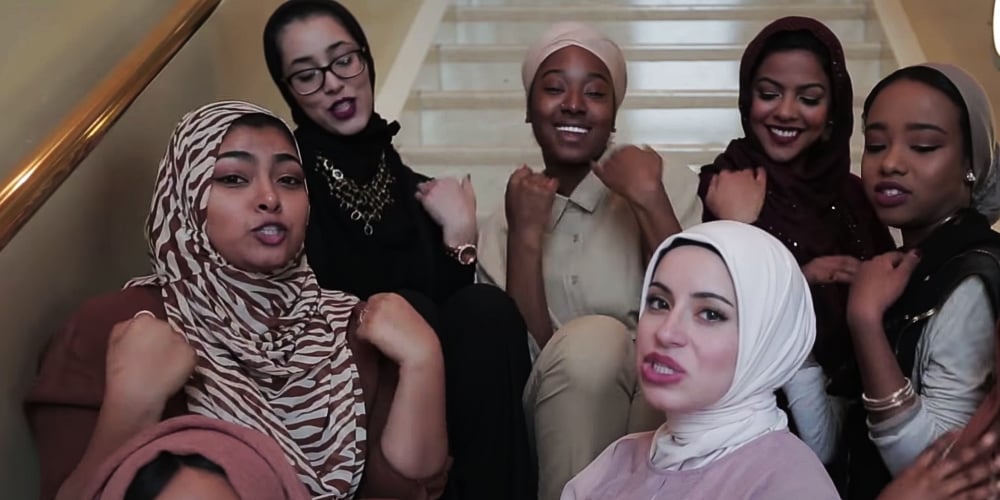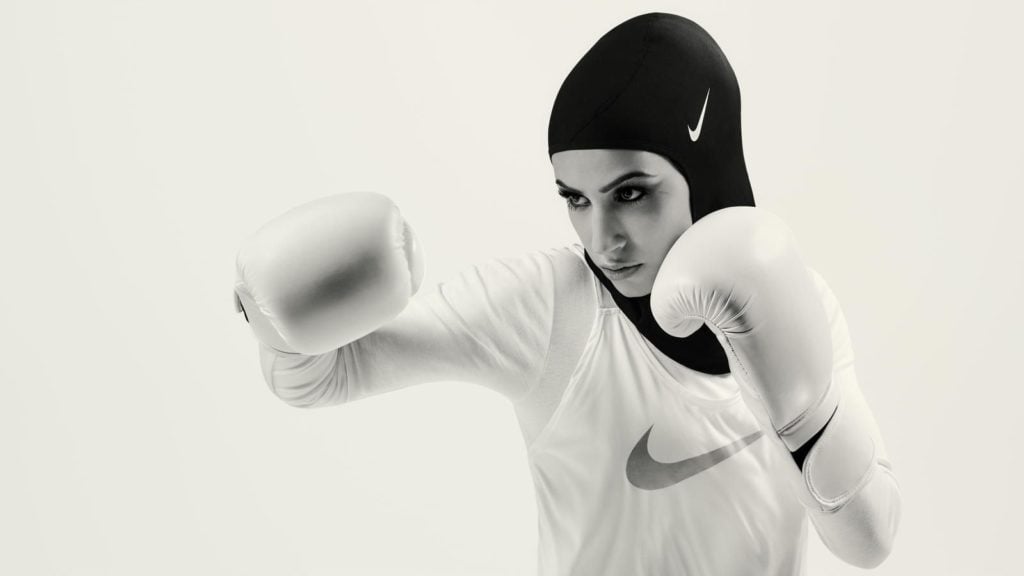There were protests weeks before the exhibition even opened.
In a rare alignment, far right groups, second-wave feminists, and self-proclaimed secular immigrants gathered in opposition against “Contemporary Muslim Fashions,” a show at the Museum Angewandte Kunst in Frankfurt. Their claim? That the headscarf on view in several exhibits is as an instrument of oppression against women and that the show was “propaganda” for Islamism and a “blast” against feminists. At the opening last Thursday evening, a small group of critics protested what they deemed a glorification of an oppressive tool and interrupted the opening ceremonies with an attempted slutwalk.

Installation view of “Contemporary Muslim Fashions” at the de Young Museum in San Francisco.
“I understand if criticism comes from Iranian and Arabic women because of their personal experiences with restrictive dress codes,” the museum’s director, Matthias Wagner K, told artnet News. “But this is not the case for all countries with Muslim populations and minorities. The exhibition explores the interpretations of fashion by Muslim women all over the world that may be rooted in religious traditions, but change constantly,”
Initiated by Max Hollein, now director of New York’s Metropolitan Museum of Art, “Contemporary Muslim Fashions” first opened at the de Young Museum in San Francisco in 2018 and was positively received as a nod to diversity and against prejudice, as it coincided with the Trump administration’s Muslim ban.
Curated by Jill D’Alessandro, Laura L. Camerlengo, and Reina Lewis, the multimedia exhibition showcases 76 costumes (only half of which feature head coverings), photos, and video installations. It includes sportswear and casual wear by Nike and Uniqlo, colorful national attires by designers from Muslim countries such as Indonesia and Pakistan, elegant haute couture ensembles made for the Qatari Sheikha Moza bint Nasser by fashion houses like Dior and Valentino, and works by four German-Austrian designers, added specifically for the Frankfurt edition.

Still from Mona Haydar’s Hijabi (Wrap my Hijab). Courtesy of YouTube.
In the show, photos and videos depict Mipsters, Hijabistas, and modest fashion influencers from both Muslim countries and Western nations with Muslim populations. (Among the people represented are American rapper Mona Haydar and German boxer Zeina Nassar.) A critical view is added with installations by artists like Boushra Almutawakel, Hengameh Golestan, and Shirin Neshat, who shed light on the mandatory headscarf in countries like Iran and Yemen.
The reality of the exhibition—and of the experiences of most of the estimated world population of 1.8 billion Muslims that fuel the growing market of modest fashion—couldn’t be further from the claims of the protesters. No doubt, the headscarf is an instrument of oppression in regions like Iran, Saudi Arabia, and the Indonesian province Aceh.

Contemporary Muslim Fashions © DarSalma Photography – Stephanie Abidi.
But the debate about “Contemporary Muslim Fashions” is otherwise absurd. It’s just another case of an object taken out of context to be politicized, another debate carried out on the female body, as if dress codes don’t apply to men (think of the Arabic keffiyeh and thobe). This seems particularly foolish in times when empowered women wear head coverings. No one would question why the young Nobel laureate Malala Yousafzai or the Somali-American politician Ilhan Omar wear these garments. Nor would anyone ask why New Zealand’s Prime Minister, Jacinda Ardern, wore one as a message of solidarity with the victims of the attacks in Christchurch on two mosque in which 50 people were killed.
But Germany is still a largely homogeneous country, culturally speaking. With the exception of the Turkish guest workers who started coming in the 1960s, immigrants to the nation have, until recently, been mostly European. For a society with a pathological anxiety of any kind of ambiguity, it is hard to understand that an object that to some is an instrument of oppression, may be a symbol of empowerment to others.

Contemporary Muslim Fashions © Nike, Inc. Nike Pro Hijab.
Max Hollein, who served as director of Frankfurt’s Städel Museum, Schirn Kunsthalle, and Liebieghaus before his stint in San Francisco, intended for “Contemporary Muslim Fashions” to upset the idea that Muslim clothing was forced onto oppressed Muslim women. His goal was to highlight the diversity of these modest fashions, and if nothing else, the show at least kicked off another widespread debate. But it’s also done more than that, by offering an disruption of prejudices about Muslim lifestyles—and that accomplishment is desperately needed in times of rising Islamophobia.
“Contemporary Muslim Fashions” is on view at Museum Angewandte Kunst, Schaumainkai 17, 60594, Frankfurt am Main, through September 15.
Follow artnet News on Facebook:
Want to stay ahead of the art world? Subscribe to our newsletter to get the breaking news, eye-opening interviews, and incisive critical takes that drive the conversation forward.
https://news.artnet.com/opinion/contemporary-muslim-fashion-1510108
2019-04-09 05:00:00Z
CBMiQ2h0dHBzOi8vbmV3cy5hcnRuZXQuY29tL29waW5pb24vY29udGVtcG9yYXJ5LW11c2xpbS1mYXNoaW9uLTE1MTAxMDjSAUxodHRwczovL25ld3MuYXJ0bmV0LmNvbS9vcGluaW9uL2NvbnRlbXBvcmFyeS1tdXNsaW0tZmFzaGlvbi0xNTEwMTA4L2FtcC1wYWdl
Tidak ada komentar:
Posting Komentar